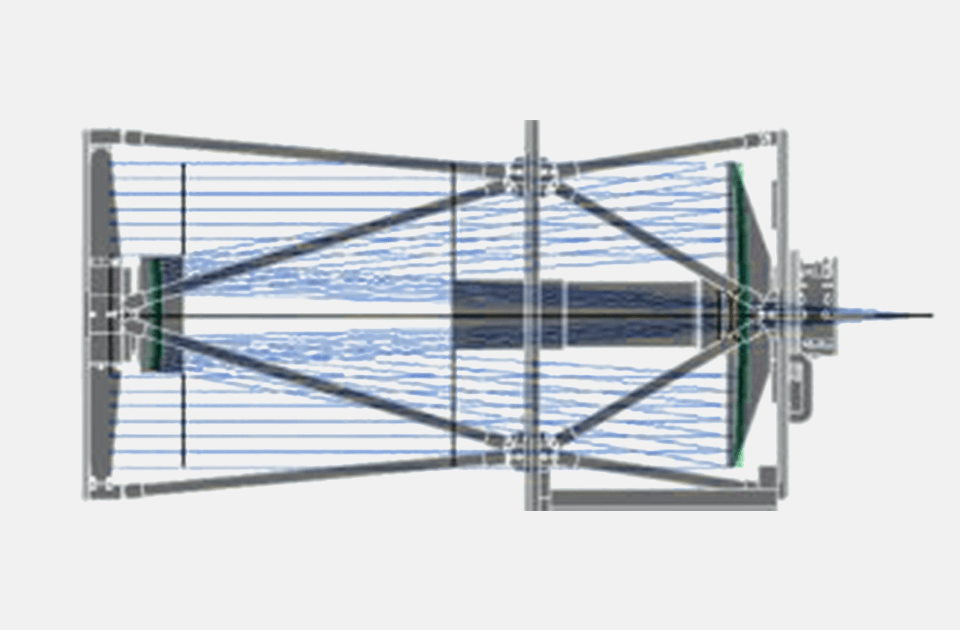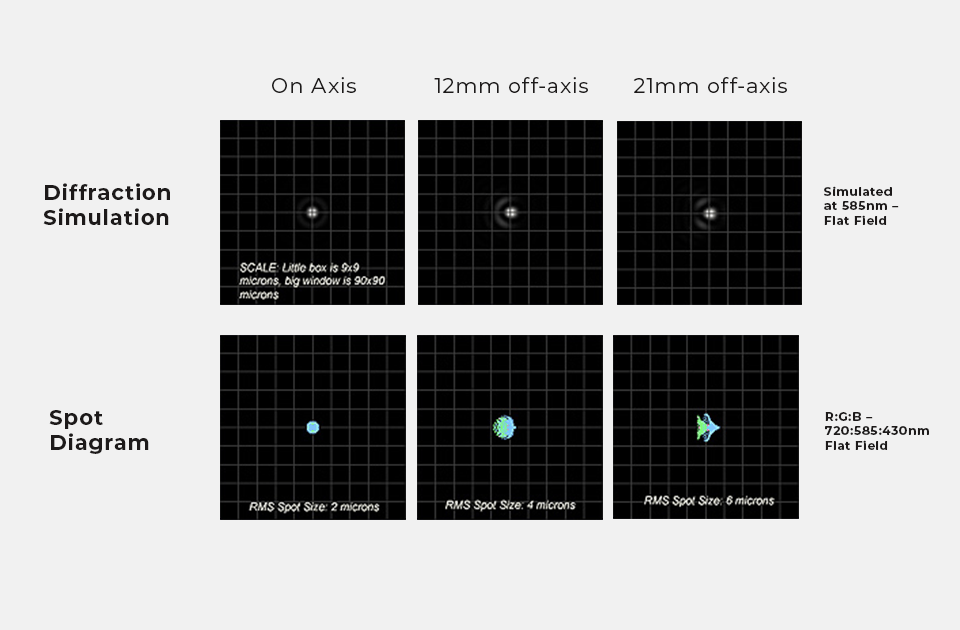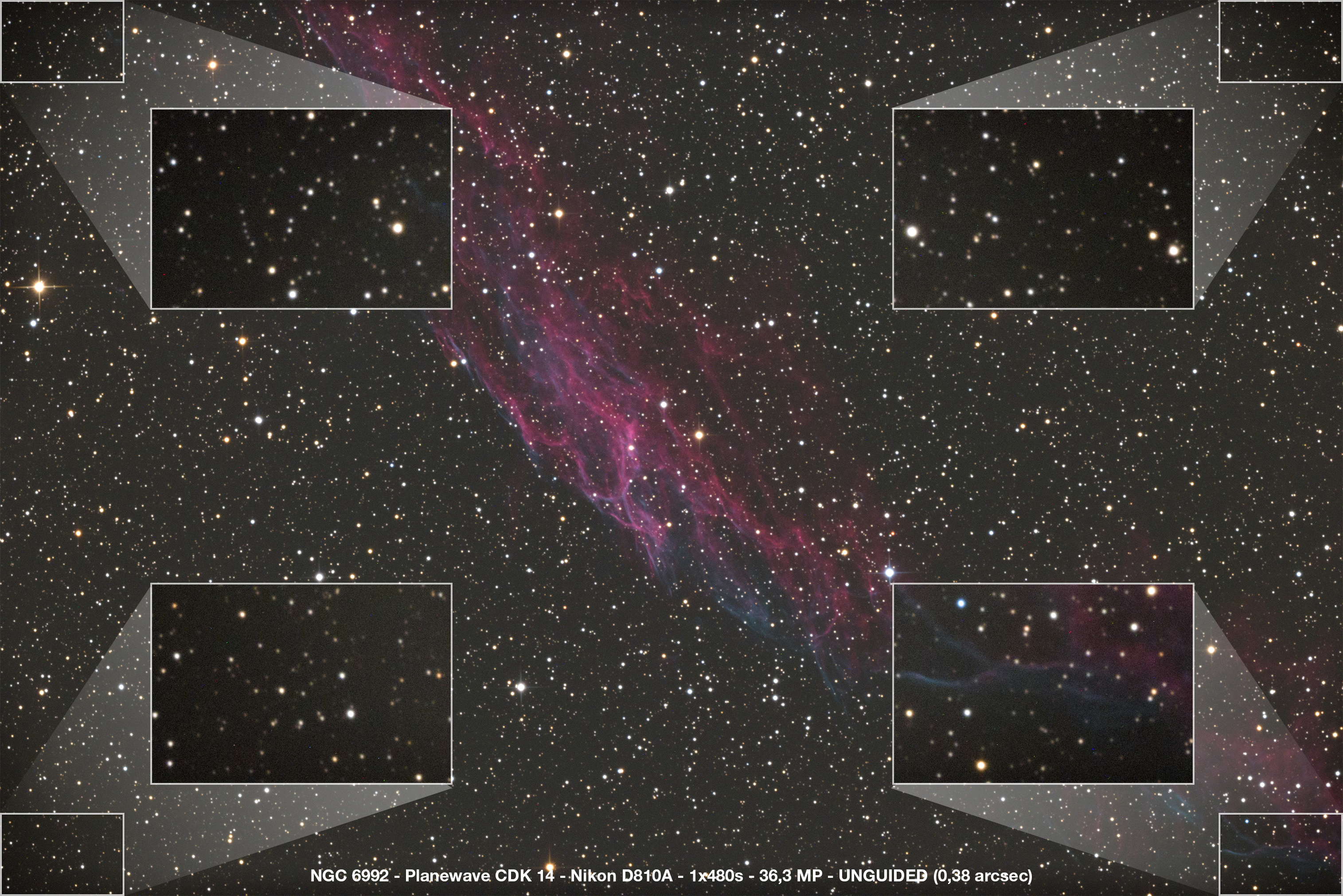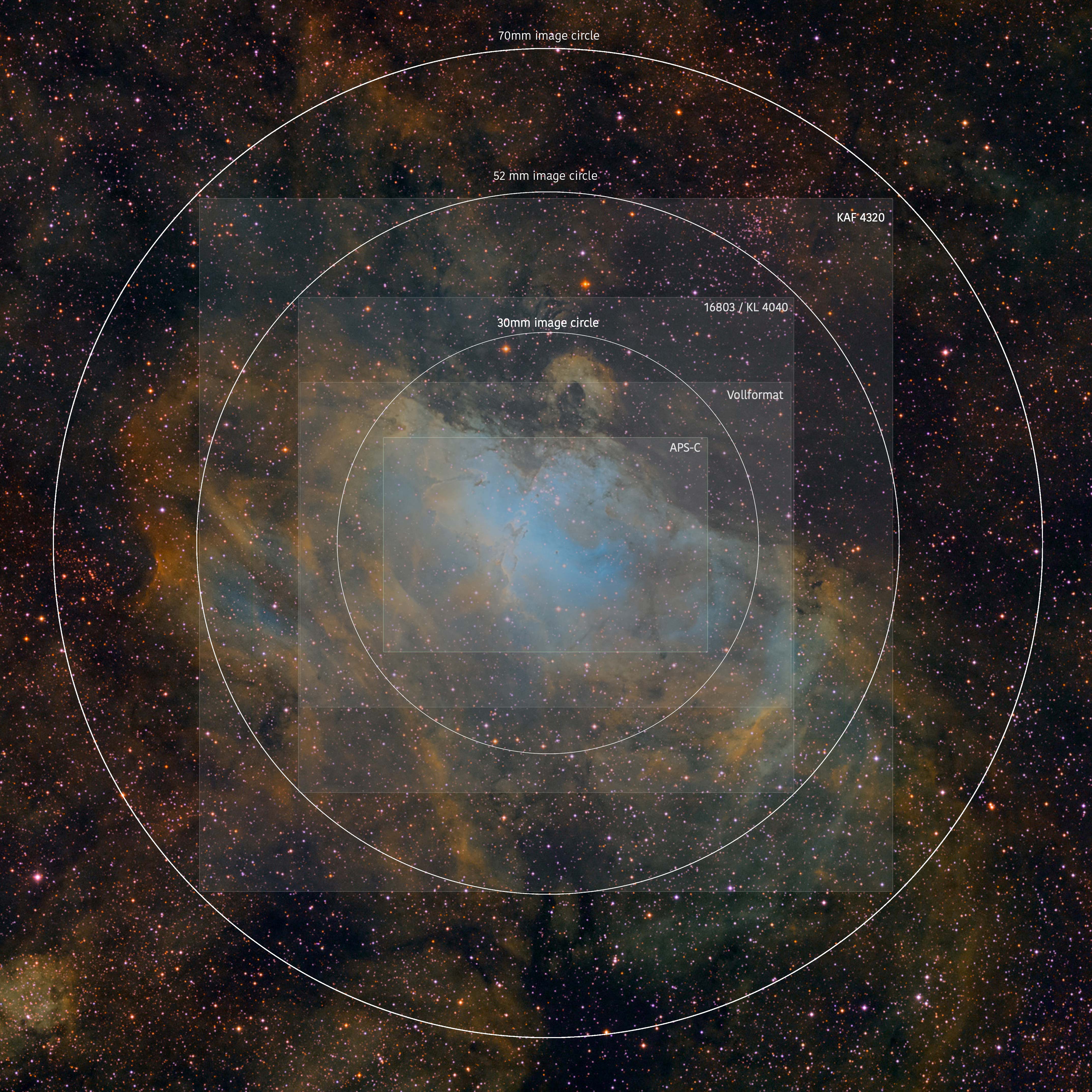
The CDK [Corrected Dall-Kirkham] telescope is based on a new optical design developed by Dave Rowe. The goal of the design is to make an affordable astrographic telescope with a large enough imaging plane to take advantage of the large format CCD cameras of today.
Most telescope images degrade as you move off-axis from either coma, off-axis astigmatism, or field curvature. The CDK design suffers from none of these problems. The end result is a telescope which is free from off-axis coma, off-axis astigmatism, and curvature of field, yielding a perfectly flat field all the way out to the edge of a 52mm image circle. This means pinpoint stars from the center out to the corner of the field of view.
The design is a simple and elegant solution to the problems posed above. The CDK consists of three components:

At this point, we will show you two diagrams, to convince you about the high image quality of the CDK20. The first is a diffraction simulation and the second is a spot diagram. In the diffraction simulation the star images on axis and off-axis are nearly identical.
In the spot diagram 21mm off-axis the spot size is an incredible 6 microns RMS diameter. For 26mm off-axis, a 52mm image circle, the RMS spot size is 11 microns. This means the stars across the entire focal plane are going to be pinpoints as small as atmospheric seeing will allow.
Both of the simulations take into consideration a flat field, which is a more accurate representation of how the optics would perform on a flat CCD camera chip.
For visual use some amount of field curvature would be allowed since the eye is able to compensate for a curved field.
The diffraction simulation was calculated at 585nm. The spot diagram was calculated at 720, 585, and 430nm. Many companies show spot diagrams in only one wavelength, however to evaluate chromatic performance multiple wavelengths are required.

The simulations shown compares the optical performance of the CDK design to the Ritchey Chrétien (RC) design. The Ritchey design was popularized as an astroimaging telescope due to its use in many professional observatories. Although very difficult and expensive to manufacture and align, the Ritchey is successful in eliminating many of the problems that plague many other designs, namely off-axis coma. However the Ritchey does nothing to eliminate the damaging effects of off-axis astigmatism and field curvature.
The CDK design tackles the off-axis coma problem by integrating a pair of correcting lenses into a two mirror design. The beauty is that this design also corrects for astigmatism and field curvature. Because the lenses are relatively close to the focal plane, and because these lenses work together as a doublet, there is no chromatic aberration.
The CDK offers a wide aberration-free, flat field of view that allows the user to take full advantage of the very large imaging chip cameras in the market place today.
Having an aberration free telescope design means nothing if the optics cannot be aligned properly. Many Ritchey owners never get to take full advantage of their instrument’s performance because the Ritchey is very difficult to collimate. Aligning the hyperbolic secondary mirror’s optical axis to the optical axis of the primary mirror is critical in the Ritchey design, and the tolerances are unforgiving. The secondary mirror of the CDK design is spherical. It has no optical axis and so the centering tolerance of the CDK secondary mirror is comparatively huge. With the help of some very simple tools, the CDK user will be able to set the secondary spacing, collimate the optics and begin enjoying the full performance potential the instrument has to offer within a few minutes.
The drastic difference in performance between the CDK and the RC is apparent. The biggest component that degrades the off-axis performance of the RC is the defocus due to field curvature.
In many diagrams shown by RC manufacturers, the diagrams look better than this because they are showing a curved field. This is fine for visual use because the eye can compensate for some amount of curvature of field. But CCD arrays are flat and so in order to evaluate the performance a spot diagrams and/or diffraction simulations requires a flat field as shown.
The small squares are 9x9 microns wide, the individual comparative images are 90 micrometers wide. The spot diagrams were calculated for a wavelength of 585 nanometers.
Furthermore, please note: the CDK design is f / 6.8, the RC design is
f / 8. This is not important for stars, but it can easily reduce the exposure time when photographing extended objects like nebulae.
When you are comparing the new CDK with a conventional RC system, both systems are considered without additional corrector optics. However, a lens correction system is already integrated in the basic concept of the CDK. But this has nothing to do with a universal corrector. The correction system is fully integrated into the optical design and makes an uncompromising imaging performance possible all over the perfectly flat field, all the way out to the edge of a 50mm image circle.
The majority of RC users use their RC systems without additional image field lenses. Such an uncorrected RC is standard in the industry. For this reason, the CDK is compared with an uncorrected RC, because a corrector for the RC is only available for (appreciable) extra charge - if at all.
Previous CCD camera series had, as you known, at most APS format (15 x 22mm). Therefore the problem of image field curvature with the RC was hardly noticed. But the new full-frame chips dramatically reveal the distortions at the edge. In particular the image field curvature at the RC does not allow for a completely sharp image (even with perfect collimation ...) with a full-frame CCD.
The CDK is providing a solution especially for the CCD's of the new generation.
The collimation of a CDK is much simpler than that of a RC. In order to achieve the same performance as in the spot comparison under real conditions, all optical components in the RC system would have to be collimated five times better than it is necessary in the CDK design. This means that a CDK with the same tube weight has got a significantly higher temperature stability and torsional rigidity compared to the RC.
A CDK-Optics delivers the same or better performance, while it costs significantly less than the RC, especially if you have to purchase a separate corrector for the RC.
Compared to a classic RC, the CDK has got a faster focal ratio and is therefore better adapted to the smaller pixels of the newer CCD cameras.
In summary – why do we offer this optical design:
In our opinion, the CDK is a telescope which provides a better or at least comparable performance as the best RC telescopes on the market - but for less money. Due to the easy adjustability, it is much easier to use this high image quality. Even if you consider the limitation by the omnipresent seeing, which generally makes the use of a perfect image quality with so long focal lengths very difficult, nevertheless the better adjustability and the lower price speak for the CDK.
As soon as good seeing conditions or as soon as fast cameras and / or with the help of adaptive optics (- and these will become the next big thing in the imaging astronomy!) are available, a perfect collimation of the optics is very important. This will be much easier to achieve in real-life with the CDK.
It seems to us that the CDK offers you a future-proof solution for a research-friendly optics. We are happy to answer your questions. Just send us an email to kontakt@baader-planetarium.de or give us a call.
The revolution triggered by the Planewave CDK optics is drastically documented by the fact that there are already first imitators. However - at only small price difference – a clear difference in the image field size is noticeable. The image field size of the Planewave CDK corresponds to a (real) RC-system (– however, in contrast to the RC, the CDKs give you a perfectly flat field).
The flat and photographically usable field of the competitors is only 30 mm large, which is almost two-thirds smaller than expected! It would be foolish to call this a real astrograph – SC mass produced Schmidt-Cassegrain performs in the same manner. Such an XYZ optics uses the word "Dall-Kirkham" only as an advertising gag.

